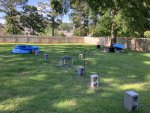Mmathis
TurtleMommy
- Joined
- Apr 28, 2011
- Messages
- 14,377
- Reaction score
- 8,400
- Location
- NW Louisiana -- zone 8b
- Hardiness Zone
- 8b
- Country

We’re always getting questions about the color of GF fry/juveniles: Why are some gold-fish juvies gold-colored and some black or dark olive colored at the same stage of life? We all know that the darker color is a way for the young fish to be camouflaged, as a defense against predators. So then, why aren’t all baby GF dark?
Disclaimer: this is not based on a scientific study, but an observation.
While we wait to have our new pond built, I have my GF housed in 2 holding “tanks” in the backyard.

BTW, water parameters are the same in both tanks.
I have noticed juvenile GF in both tanks. The ones in tank #2 (direct sunlight with sad looking plants) are dark.
The ones in tank #1 (less sunlight, clearer water, healthy plants) are gold.
So, I’m just wondering if the individual environments in the 2 tanks has anything to do with the way first-color manifests itself — as a protective mechanism? The juvie fish that are dark are in the tank (#2) that gets more exposure and has the worst plant coverage. The fish that are gold, are less exposed and have a rain forest of plants for coverage (#1). IOW, the fish in the exposed (#2) tank are more vulnerable to predation, so stay dark longer, while the fish in the “protected” (#1) tank don’t feel as threatened, so don’t go through the dark phase.
IDK, just an observation.
Disclaimer: this is not based on a scientific study, but an observation.
While we wait to have our new pond built, I have my GF housed in 2 holding “tanks” in the backyard.
- One is a 300 gallon Rubbermaid stock tank (connected to a SKIPPY filter). The bulk of the fish, along with a ton of plants (anacharis and parrot feather) are in this tank. It sits under an oak tree and gets very little direct sunlight — but does get a few hours of afternoon sunlight. This water is crystal clear and on the cooler side. The plants are thriving: green, fluffy, etc., as are the fish. These fish are visible and friendly.
- ”Tank” #2 is an Intex pool (not sure about the capacity, but it is al least as big if not bigger than the stock tank). It has about a dozen GF (not sure how many are left after the egret attack), and again, a ton of plants. It sits in the middle of the yard, in direct sunlight almost all day (morning shade). The filter is a box filter with a spray head (and I just hooked up my Oase SwimSkim skimmer). The water in this “tank” isn’t as pretty as the #1 tank. The water temp is a few degrees higher. The plants all look like they’ve seen better days (I occasionally rotate them with the other tank)...and just look sad
. The fish in this one are thriving and getting big! But they are more shy and you only see them if you sneak up.

BTW, water parameters are the same in both tanks.
I have noticed juvenile GF in both tanks. The ones in tank #2 (direct sunlight with sad looking plants) are dark.
The ones in tank #1 (less sunlight, clearer water, healthy plants) are gold.
So, I’m just wondering if the individual environments in the 2 tanks has anything to do with the way first-color manifests itself — as a protective mechanism? The juvie fish that are dark are in the tank (#2) that gets more exposure and has the worst plant coverage. The fish that are gold, are less exposed and have a rain forest of plants for coverage (#1). IOW, the fish in the exposed (#2) tank are more vulnerable to predation, so stay dark longer, while the fish in the “protected” (#1) tank don’t feel as threatened, so don’t go through the dark phase.
IDK, just an observation.
